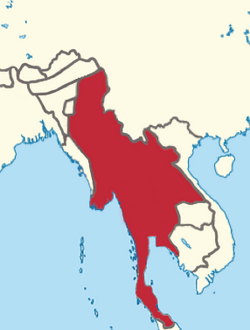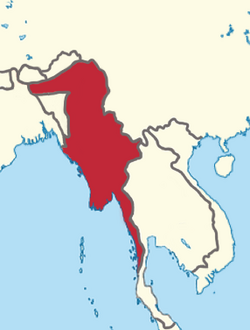
Back أسرة كونباونغ Arabic Dinastía Konbaung AST Конбаун Bashkir কোনবাউং রাজবংশ Bengali/Bangla Dinastia Konbaung Catalan Dynastie Konbaung Czech Konbaung-Dynastie German Dinastía Konbaung Spanish Konbaung dinastia Basque Konbaung-dynastia Finnish
Konbaung Dynasty | |
|---|---|
| 1752–1885 | |
 Konbaung Empire in 1767 | |
 Konbaung Empire in 1824 | |
| Status | Empire |
| Capital | |
| Common languages | Burmese |
| Religion | Theravada Buddhism (official) |
| Demonym(s) | Burmese |
| Government | Absolute monarchy |
| Monarch | |
• 1752–1760 (first) | Alaungpaya |
• 1763–1776 | Hsinbyushin |
• 1782–1819 | Bodawpaya |
• 1853–1878 | Mindon Min |
• 1878–1885 (last) | Thibaw Min |
| Legislature | Hluttaw |
| Historical era | Early modern period |
• Founding of dynasty | 29 February 1752 |
• Reunification of Burma | 1752–1757 |
| 1759–1812, 1849–1855 | |
| 1765–1769 | |
• Conquest of Arakan | 1785 |
| 1824–1826, 1852, 1885 | |
• End of dynasty | 29 November 1885 |
| Area | |
| 1824[8] | 794,000 km2 (307,000 sq mi) |
| Population | |
• 1824 | 3,000,000[8] |
| Currency | kyat (from 1852) |
| Today part of | |
| History of Myanmar |
|---|
 |
|
|
|
|
|
|
The Konbaung dynasty (Burmese: ကုန်းဘောင်မင်းဆက်), also known as the Third Burmese Empire (တတိယမြန်မာနိုင်ငံတော်),[9] was the last dynasty that ruled Burma from 1752 to 1885. It created the second-largest empire in Burmese history[10] and continued the administrative reforms begun by the Toungoo dynasty, laying the foundations of the modern state of Burma. The reforms, however, proved insufficient to stem the advance of the British Empire, who defeated the Burmese in all three Anglo-Burmese Wars over a six-decade span (1824–1885) and ended the millennium-old Burmese monarchy in 1885. Pretenders to the dynasty claim descent from Myat Phaya Lat, one of Thibaw's daughters.[11]
An expansionist dynasty, the Konbaung kings waged campaigns against the Lushai Hills, Manipur, Assam, Arakan, the Mon kingdom of Pegu, Siam (Ayutthaya, Thonburi, Rattanakosin), and the Qing dynasty of China – thus establishing the Third Burmese Empire. Subject to later wars and treaties with the British, the modern state of Myanmar can trace its current borders to these events.
Throughout the Konbaung dynasty, the capital was relocated several times for religious, political, and strategic reasons.
Cite error: There are <ref group=lower-alpha> tags or {{efn}} templates on this page, but the references will not show without a {{reflist|group=lower-alpha}} template or {{notelist}} template (see the help page).
- ^ စစ်သည်တို့ကိုစည်းရုံးဆင့်ဆိုသည့်အမိန့်တော် [Royal Order Summoning the Warriors], Hluttaw Clerk Maha Minhla Minhtin Sithu, 1st Waxing Day of Tazaungmon, 1247 ME (1885 CE), national archives
- ^ တက္ကသိုလ်စိန်တင် (June 2005). သီပေါဘုရင်နှင့် စုဖုရားလတ် [King Thibaw and Supayalat]. Archived from the original on 6 November 2022. Retrieved 7 August 2022.
- ^ Mister Maung Hmaing (1914). ဒေါင်းဋီကာ [Peacock Details]. Archived from the original on 6 November 2022. Retrieved 28 March 2022.
- ^ ဝရဇိန် (ဆရာစံမြေ) (September 2011). မြန်မာ့သမိုင်းဝင်အလံများနှင့် မြန်မာခေါင်းဆောင်မျာ [Myanmar's Historical Flags And Myanmar Leaders]. Archived from the original on 6 November 2022. Retrieved 28 March 2022.
- ^ "Part 2, Treatise about State Seals and State Flags Used Through Successive Periods In Myanmar" (in Burmese). 5 February 2014. p. 6.
Presenter: Yi Yi Nyunt, Director, Nationalities Youth Resources Development Degree College Sagaing, Department of Education and Practising, Ministry of Border Affairs, Republic of the Union of Myanmar. - ^ ဗန်းမော်တင်အောင် [in Burmese]. မြန်မာနိုင်ငံတော်သမိုင်း [Myanmar State History]. Archived from the original on 10 December 2022. Retrieved 28 March 2022.
- ^ "စံရာတောင်ကျွန်းမှသည် မြူမှောင်ဝေကင်းသို့" [From standard mountain island to darkness]. Myanmar Digital News (in Burmese). 8 April 2019. Archived from the original on 25 October 2022. Retrieved 25 October 2022.
- ^ a b Harvey 1925, p. 333.
- ^ Scott, Paul (8 July 2022). "Property and the Prerogative at the End of Empire: Burmah Oil in Retrospect". Social Science Research Network. doi:10.2139/ssrn.4157391. S2CID 250971749. SSRN 4157391.
- ^ Ni 2013, p. 7.
- ^ "The Second Princess, daughter of King Thibaw". Lost Foot Steps. Archived from the original on 24 October 2022. Retrieved 24 October 2022.

![State Seal[a][1][2] of Konbaung](http://upload.wikimedia.org/wikipedia/commons/thumb/7/71/State_seal_of_the_Konbaung_dynasty.svg/85px-State_seal_of_the_Konbaung_dynasty.svg.png)